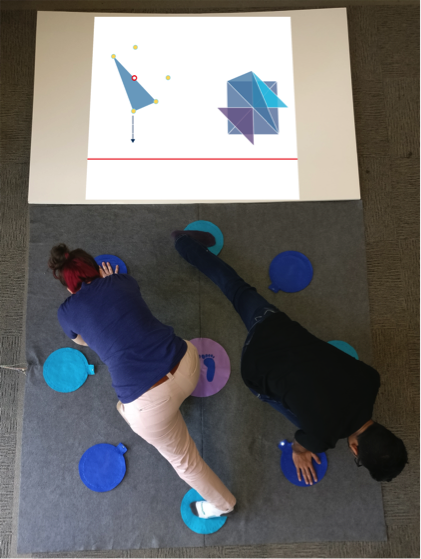Aim: Create an engaging environment in which learners can have a collaborative, embodied experience of geometry.
Team Members: Kimiko Ryokai (School of Information), Dor Abrahamson (Graduate School of Education), Elena Durán–López (SESAME), Ganesh V. Iyer (MIMS ’17), and Leah Rosenbaum (EMST)
Duration: Fall 2016 – Present
Funding: CITRIS Tech for Social Good Grant; Barbara White Bequest
Awards: Featured Exhibit at the Lawrence Hall of Science, Berkeley Inventors’ Showcase 2018; CHI 2017 Best Student Game Competition: ‘Games for a Purpose’; IDC 2017 Best Demo Paper
Background: Elena, Ganesh, and Leah came together as the Geometris team during Fall 2016 in Professor Kimiko Ryokai’s course on Tangible User Interface (TUI) design. Bringing together interests in education, designing for children, and games, we brainstormed for weeks, and after much iteration and guidance (thanks Kimiko and Noura!), we came up with the idea for Geometris. We got lots of positive feedback during the end-of-term TUI showcase and decided to continue working on the project.
Motivations: There exists a cultural narrative that mathematics is a solitary and abstract domain of formulas and number-crunching. This narrative misrepresents the work of many professional mathematicians, and, more importantly, does little to motivate or engage young mathematics learners. With Geometris, we present a different experience of mathematics. This embodied, collaborative mathematics-based game relies on interpersonal communication and cooperation rather than on numbers or calculations. It aims to leverage students’ play-based physical movements as a resource for talking and thinking about shapes, angles, and spatial relationships.

Gameplay: The Geometris environment is composed of a 6×6 ft interactive mat and a 4×6 ft projection area (Figure 1). Two dimensional shapes are projected onto the floor near the mat, descending from the top of the projection area toward the red line at the bottom. Players coordinate their bodies to create the shapes on the mat by pressing pressure-sensitive pads that correspond to the vertices of the projected shape. Real-time feedback is provided both through an LED on each pad and in the projected image. Successfully created shapes are overlaid into a design that represents the players’ score (Figure 1). Geometris levels vary in difficulty by the number of vertices in each shape, the diversity of shapes (all triangles vs. triangle, rectangles, and hexagons), and the asymmetry of shapes.
Current Work: We are currently designing a study to evaluate the impact of scale on this embodied game. Specifically, we intend to compare two versions of Geometris: the floor-based version (Figure 1) and a 10×10 inch table-top version played with fingers instead of limbs. We might reasonably expect significant differences in what learners notice and reason about if they are pinching their fingers vs. stretching their limbs vs. coordinating their whole body with another classmate. In short, we can reasonably expect differences in scales of embodiment. We plan to focus primarily on how players understand the interaction (the game rules and challenges) as well as the strategies and resources (including each other) that they call upon to accomplish their goals. We also plan to quantify and compare players’ proficiency at the game itself.
Publications:
- Rosenbaum, L. F., Kaur, J., & Abrahamson, D. (2020). Shaping perception: Designing for participatory facilitation of collaborative geometry.In R. Nemirovsky & N. Sinclair (Eds.), “On the intertwined contributions of physical and digital tools for the teaching and learning of mathematics” . Digital Experiences in Mathematics Education, 6(2), 213–232. https://doi.org/10.1007/s40751-020-00068-2(Read More)
- Durán–López, E., Rosenbaum, L. F., & Iyer, G. V. (2017). Geometris: Designing collaborative mathematical interactions for children.P. Blikstein, D. Abrahamson, M. Worsley, & J. Fails (Eds.), “Logo: The Next 50 Years” – Proceedings of the 16th annual Interaction Design and Children conference (IDC 2017) (Vol. “Demos,” pp. 697-700). Stanford University: IDC.(Read More)
- Durán–López, E., Iyer, G. V., Rosenbaum, L. F. (2017). Geometris: A collaborative embodied geometry game G. Mark, S. Fussel, F. Mueller, & J Tanenbaum (Eds.), “Explore Innovate Inspire” – Proceedings of the 35th annual Conference on Human Factors in Computing Systems (CHI 2017) (Vol. “Student Game Competition,” pp. 214-217). Denver: CHI.(Read More)